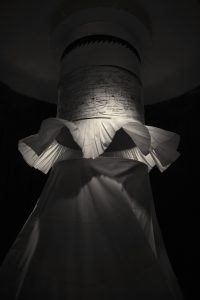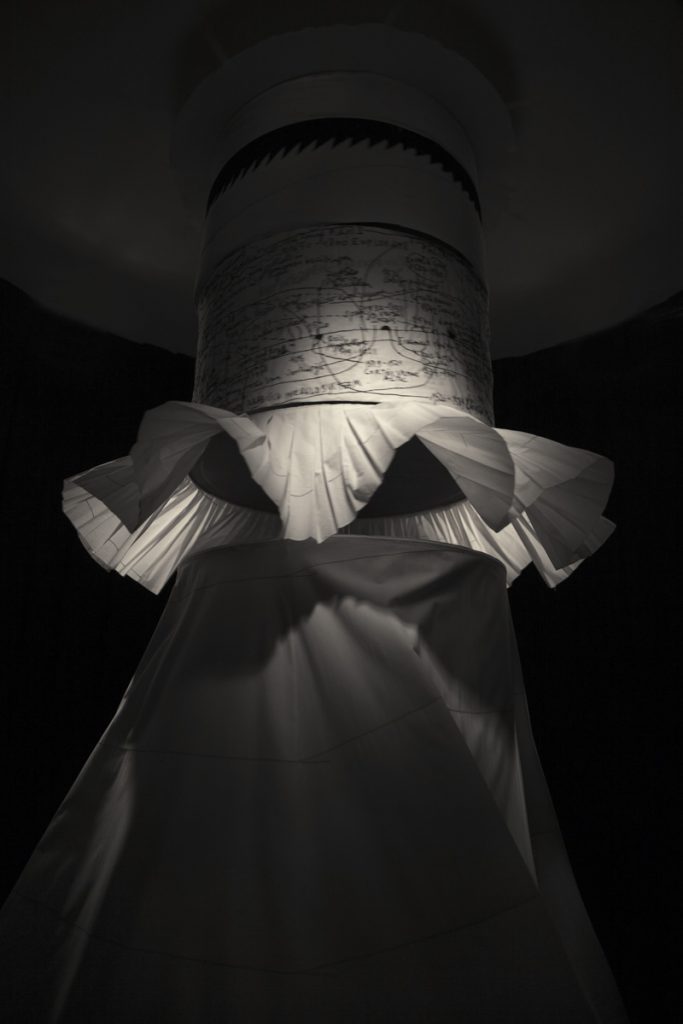Christoph Fink
'Vortex der Heerlijkheid' - reprise
voor vijf motoren, lakens en borduurwerk
21.10.2010 — 18.12.2010
[NL]
Christoph Fink noemt de reizen die hij met de fiets, de trein, het vliegtuig of te voet onderneemt, ‘bewegingen’. Tijdens deze reizen maakt hij vrijwel continu korte notities, die hij later in tekeningen, schema’s, sculpturen en tabellen verwerkt. Christoph Finks werk bestaat juist uit het documenteren van de tussenstadia tussen ‘hier’ en ‘daar’ en uit het ontvangen van impulsen als reiziger op zijn weg. Het werk dat Christoph Fink in LLS 387 toont, ‘Vortex der Heerlijkheid’, vertrekt vanuit deze artistieke methode maar blijkt deze eveneens te overstijgen, in die zin, dat het de wereldlijke context in beeld brengt waarin de ‘atlas der bewegingen’ functioneert. We zien een grote ronddraaiende zuil, een ‘pop’, een ‘bruid’ met op haar ‘kleed’ zo’n 2000 jaar geschiedenis van de mensheid vanuit Westers perspectief geborduurd. Het object heeft een luchtige maar theatrale verschijning, het is een uitbundig wezen dat o.a. op fanfaremuziek, de Mechelse beiaard en op straatgeluiden van Palestina danst. Frivool, met veel allure, wijst het ons op de menselijke glorie en dwaasheid en laat het ons met een glimlach achter. Het object is vergezeld van een affiche, dat als een soort ‘handleiding’ fungeert en ons een blik laat werpen op de ontstaansgeschiedenis van het werk. ‘Vortex der Heerlijkheid’ werd oorspronkelijk gerealiseerd in het kader van de festiviteiten rond het 450-jarige bestaan van het bisdom Mechelen vorig jaar als een grotesk stadsportret ingeschreven in de wereldgeschiedenis. In LLS 387 wordt een aangepaste versie getoond.
Christoph Fink schrijft over zijn werk:
‘Vortex der heerlijkheid’. ‘Vortex’ is een werveling: ik denk aan een mobiele structuur, een wentelende figuur die het ijle van het denken en het onmogelijke van het vatten van de werkelijkheid in zich draagt.’ ‘Heerlijkheid’ is ontleend aan één van de vroegere stadstitels die gepaard ging met privileges. Vandaag is het een ambigu woord. <…> Het portret van de stad werd een portret van onze tijd. Een draaiende kolom van wit laken, tweehonderd jaar per omwenteling, een toren van een slordige tweeduizend jaar (-160, in de aangepaste versie). Een nieuwe lezing van ons geschiedkundig geheugen letterlijk openend met de Renaissance en het humanisme. Gevolgd door de grote transitieperiode van de 15de en 16de eeuw (tegengesteld draaiend), waar de bloedige scheiding der politieke en godsdienstige machten op metafysische en tegelijkertijd opportunistische wijze werd beslecht. Een tijd die gekenmerkt werd door een ontluikend modernisme dat de weg zal wijzen naar onze tijd. Daarboven troont de industriële periode van steenkool en olie, stoom en elektriciteit (het zwarte stroboscoop gedeelte). Het tijdperk der massaindoctrinaties brak aan, deels resulterend in samenlevingsexperimenten op een niet of anders christelijke basis (Derde Rijk, Communisme, Kapitalisme…), met de grote wereldoorlogen tot gevolg. Ten slotte is er onze tijd: de centrifugale periode zoals ik ze noem, het prille nano-tijdperk en een mogelijks nieuwe moderniteit. <…> Ik beschouw de sculptuur tevens als een schets, een studie of denkvorm. Een mantel der geschiedenis als bron van mogelijkheden. <…>
Met Dank aan Christoph Fink, Martin Blank, Wim Catrysse, Extra City, Charlotte Geudens, Jean Michel Louel, Ria Pacquée, Lee Preedy, Cateau Robberechts, Kirsten Trippaers en Joëlle Tuerlinckx


[EN]
A Vortex of (Lordly) Bliss
Reprise for Five Engines, Linen and Embroidery
Christoph Fink calls the journeys he makes by bike, train, plane or foot, ‘movements’. He makes frequent brief notes as he goes along, which are later turned into drawings, diagrams, sculptures and tables. It is this very documenting of the intermediate stages between ‘here’ and ’there’, of the impulses received by a traveller on his way, that makes up Fink’s oeuvre. The work Fink is currently exhibiting in LLS 387, ‘A Vortex of (Lordly) Bliss’, takes this artistic method as its starting point but also extends it, in the sense that it shows the worldly context in which the ‘atlas of movements’ functions. We see a large rotating pillar, a ‘doll’, a ‘bride’ with almost 2000 years of human history embroidered (from a Western point of view) on her ‘gown’. The object has a light yet dramatic presence; it is an exuberant and effervescent entity that dances to the music of brass bands, Mechelen carillons, Palestinian street sounds… Frivolously, with great charm, it shows us human folly and glory, and leaves us with a smile. A poster accompanying the object acts as a kind of ‘guide’ and gives us a glimpse of the work’s creation process. Originally created as part of the celebration last year of the 450th anniversary of the bishopric of Mechelen, ‘A Vortex of (Lordly) Bliss’ is a grotesque portrait of the city inscribed in world history. LLS 387 shows a specially adapted version.
Christoph Fink says of his work: ‘Vortex der heerlijkheid’ [‘A vortex of (lordly) bliss’]. A ‘vortex’ is a whirling movement: it brings to mind a dynamic structure, a revolving figure that contains the rush of thoughts and the impossibility of grasping reality. The term ‘heerlijkheid’ comes from one of the earlier city titles that brought with it privileges. It is now an ambiguous word. <…> The portrait of the City became a portrait of our time. A whirling column in white cloth, two hundred years at each turn, a tower of roughly two thousand years (-160 years, in the adapted version). A re-reading of our historic memory literally folding open with the Renaissance and Humanism. Followed by, turning in reverse, the wild transition period of the 15th and 16th century where the division of State and Religion was forced out of a bloody dispute fought in a metaphysical and opportunistic manner: the source of Modernism and a passage towards our time. Above thrones the industrial period of coal, oil, steam and electricity (black stroboscopic part) followed by the era of mass indoctrinations and the big world wars, derived from societal experiments on a non or other Christian basis (Third Reich, Communism, Capitalism…). And at last the centrifugal period as I named it, the debut of nano time and a possible new modern. <…> I see the concept of this sculpture also as a sketch, study or a form of thought. A coat of History as a source of possibilities.
With thanks to Christoph Fink, Martin Blank, Wim Catrysse, Extra City, Charlotte Geudens, Jean Michel Louel, Ria Pacquée, Lee Preedy, Cateau Robberechts, Kirsten Trippaers en Joëlle Tuerlinckx
